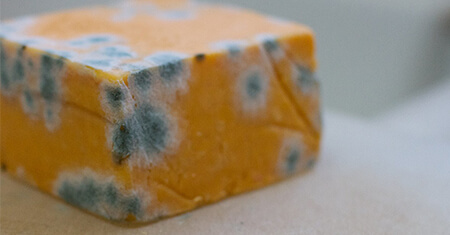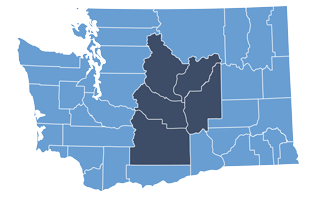WHAT IS MOLD?
Mold is a natural substance in the form of a wool-like or furry growth of tiny fungi which develops when organic material is exposed to warm or moist air over a long time. Molds can also grow on decayed organic material. They can be found anywhere from bathrooms, housing walls, doors, kitchens and laundry rooms. They can grow on any substance such as wood, paper, carpet and even on food as long as moisture is present.
TYPES OF MOLD
There are over a thousand different species of molds. Some of these are considered harmless while others can cause health effects depending on the species and extent of exposure. The most common types of mold found in homes and commercial buildings include:

Cladosporium:
- Thrives in both warm and cold conditions
- Grows on substances like fabric, carpets, and upholsteries
- Olive-green or brown colored with a suede like texture
- Causes irritation to the eyes, throat and skin
Penicillium:
- Found inside insulation, furnishings, water damaged furniture, carpeting, food and more
- Easily airborne and capable of spreading quickly in homes
- Causes sinus infections and various allergic infections
- Blue or green surface color with a velvety texture
Aspergillus:
- Common indoor mold
- 22 of the 185 species are known to cause human illness
- Grows in an array of different colors (depending on the species)
- Grows in thick layers, forming long chains of mold growth along various surfaces
- Causes asthma attacks (in people with asthma) and respiratory inflammation
Alternaria:
- Most common form of allergenic mold in the world
- Velvety texture with dark green or brown hairs
- Grows in places prone to dampness such as showers, bathrooms, below leaking sinks
- Causes asthma-like symptoms including in the upper respiratory tract, nose and mouth.
- Because it spreads quickly, it’s important to remediate alternaria mold immediately before it overtakes a home
Stachybotrys:
- “Black mold” or “toxic mold”
- Thrives in areas saturated with moisture or high humidity
- Grows on substances made with cellulose such as wood, paper, cardboard, hay or wicker
- Dark green color with a slimy texture
- May release mycotoxins into the air which can cause serious health problems
- Burning sensation in the nasal passages, cough, fever and body aches
SYMPTOMS AND EFFECTS OF MOLD ON HUMAN HEALTH
Molds produce irritating substances, which can act as allergy causing substances in sensitive individuals. Some people are more sensitive to mold while others can begin to develop severe sensitivity to mold after a long period of exposure. Children, seniors, pregnant women and people with pre-existing health conditions are particularly vulnerable to the effects of mold. Some of these symptoms are:
· Wheezing
· Rash
· Watery eyes
· Runny nose
· Itchy eyes
· Coughing
· Redness of the eye
· Chest and nasal congestion
The Institute of Medicine (IOM) once reported there was sufficient evidence to link indoor exposure to mold with upper respiratory tract symptoms. People with pre-existing health conditions (e.g. asthma) may get serious infections in their lungs when exposed to mold as prolonged exposure can worsen the condition.
PREVENTING MOLD AND ITS GROWTH
While it is impossible to eliminate all the mold growth in your indoor environment, it is good to know that mold growth can be prevented. The mold spores will not grow in the absence of moisture. So the control of moisture is the best way to prevent mold growth. If you notice mold growing in your home, it is important to clean up the mold and fix the problem causing the dampness. If you don’t fix the problem, the mold will most likely return.
Some of the best ways to prevent mold growth include:
· Eliminating the source of dampness in homes. This could be by fixing water leakages in pipes, walls, roof leakages and groundwater seepage.
· Using dehumidifiers or Air Conditions to help keep humidity level low.
· Proper ventilation of indoor areas. Opening windows and doors or the use of ventilation fans in areas such as bathrooms, showers, and kitchens to quickly dry up the air.
· Remove or replace all carpets and upholstery that have been soaked with water and can’t be dried properly. Consider not using carpets in rooms and areas like bathrooms and basements, which may have a lot of moisture.
· Adding mold inhibitors to paint before painting. It should be noted that mold inhibitors in paint helps to prevent mold growth. It is advisable to clean up existing mold before painting rather than painting over the mold.
· Emptying and cleaning out refrigerator drip pans in kitchens.
· Recycle or toss old books and newspapers. If left in damp places, such as basements, they can quickly become moldy.
PROFESSIONAL MOLD CLEANING SERVICES
You can only do so much when it comes to controlling mold growth. Mold clean up procedures depend on the extent of the mold growth and the type of surface affected. While it is necessary to get rid of mold, it is also important to know when to call professional services for help.
Such instances when to do this include:
· When there has been a lot of water damage and mold growth covers a large area of more than 10 square feet.
· If the water or mold damage is caused by sewage or contaminated water, you may need to call a professional with experience in cleaning and fixing buildings damaged by contaminated water.
· When the mold keeps on coming back even after thorough and repeated cleaning.
· When you think a mold might be a toxic mold because you, a family member or a home occupant is suffering from unexplained symptoms that may be related to exposure to toxic mold.
With so much to know about the different types of mold, how to identify them and what their potential health hazards are, it is always best to contact a professional when it comes to mold remediation. Professionals have the knowledge and experience to safely and effectively get rid of mold in your home.

